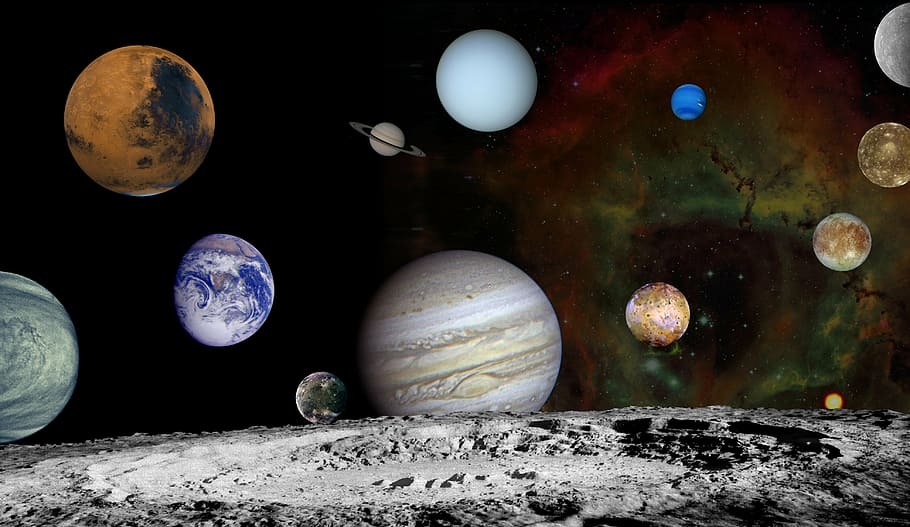The Solar System is a fascinating and complex arrangement of celestial bodies that orbit our Sun. This intricate cosmic neighborhood consists of planets, moons, dwarf planets, comets, asteroids, and a variety of other objects. Understanding the Solar System provides insight into the origins and mechanics of our planetary system and enhances our knowledge of the universe.
The Sun
At the center of the Solar System lies the Sun, a massive, glowing ball of hot plasma that generates light and heat through nuclear fusion. The Sun’s gravity holds the Solar System together, influencing the orbits of all its constituent bodies.
The planets
The Solar System contains eight major planets, each unique in its characteristics:
1. Mercury
- Closest planet to the Sun.
- Smallest of the eight planets.
- Known for its extreme temperature variations and heavily cratered surface.
2. Venus
- Second planet from the Sun.
- Similar in size and structure to Earth but with a thick, toxic atmosphere.
- Surface temperatures are hot enough to melt lead due to a runaway greenhouse effect.
3. Earth
- Third planet from the Sun.
- The only known planet to support life.
- Features diverse climates and a balanced atmosphere of nitrogen and oxygen.
4. Mars
- Fourth planet from the Sun, known as the Red Planet.
- Characterized by its red color due to iron oxide on its surface.
- Home to the largest volcano and canyon in the Solar System.
5. Jupiter
- Fifth planet from the Sun and the largest in the Solar System.
- A gas giant with a composition mainly of hydrogen and helium.
- Famous for its Great Red Spot, a giant storm larger than Earth.
6. Saturn
- Sixth planet from the Sun, known for its extensive ring system.
- A gas giant like Jupiter, with a similar composition.
- Rings are made of ice and rock particles.
7. Uranus
- Seventh planet from the Sun.
- An ice giant with a blue-green color due to methane in its atmosphere.
- Uniquely rotates on its side, likely due to a massive collision.
8. Neptune
- Eighth and farthest known planet from the Sun.
- An ice giant similar to Uranus, with a deep blue color.
- Known for its strong winds and storms, including the Great Dark Spot.
Moons
Moons, or natural satellites, orbit many of the planets in the Solar System. Notable examples include:
- Earth’s Moon: the only natural satellite of Earth, affecting tides and stabilizing the planet’s axial tilt.
- Jupiter’s Galilean Moons: Io, Europa, Ganymede, and Callisto, each with unique characteristics. Europa, for instance, may harbor an ocean beneath its icy crust.
- Saturn’s Titan: larger than Mercury, with a thick atmosphere and lakes of liquid methane.
- Neptune’s Triton: known for its retrograde orbit and geysers of nitrogen.
Dwarf planets and other objects
Beyond the major planets, the Solar System contains several dwarf planets, such as Pluto, Eris, Haumea, Makemake, and Ceres. These smaller bodies share some characteristics with the larger planets but do not dominate their orbits.
- Asteroids: mostly found in the asteroid belt between Mars and Jupiter. They are rocky remnants from the early Solar System.
- Comets: icy bodies that originate from the outer Solar System, notably the Kuiper Belt and Oort Cloud. When near the Sun, they develop bright comas and tails.
The Kuiper Belt and Oort Cloud
The Kuiper Belt extends beyond Neptune’s orbit and contains many small icy bodies, including dwarf planets like Pluto. Farther out, the Oort Cloud is a spherical shell of icy objects that marks the boundary of the Solar System.
The Solar System is a dynamic and diverse region of space, teeming with various celestial bodies. From the scorching surface of Mercury to the icy plains of Pluto, each component contributes to the overall structure and complexity of our cosmic neighborhood. Studying these objects not only helps us understand our own planet better but also provides a window into the workings of planetary systems beyond our own.


